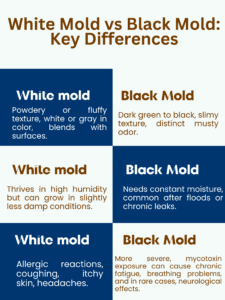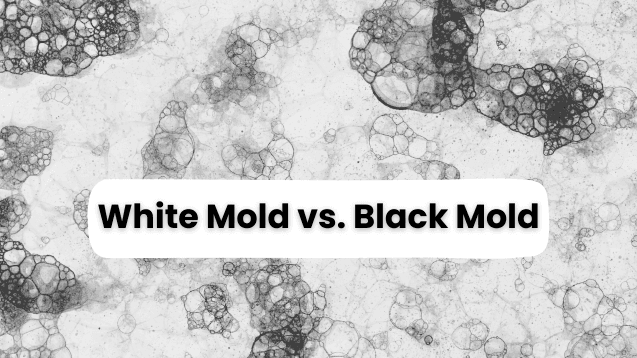When you find mold creeping into your home, panic often sets in. But before you reach for bleach or Google frantic solutions, it’s important to understand what kind of mold you’re dealing with. The two most common (and concerning) culprits are white mold and black mold, and while they may look different, both can cause serious damage to your health and property.
In this guide, we’ll break down white mold vs black mold, explain the dangers of each, and give you professional tips for safe removal and prevention.
Understanding White Mold
White mold is a blanket term for various fungal species that appear white, gray, or even powdery. It commonly grows on wood, drywall, and fabric in areas with excess moisture.
Unlike black mold, white mold can be tricky to spot because it blends with surfaces, often mistaken for efflorescence (a harmless salt deposit). But make no mistake, white mold can still trigger allergies, irritate skin, and damage organic materials in your home. According to the CDC, over 21% of U.S. homes have some form of visible mold growth, with white mold being a frequent type on wood framing.
Understanding Black Mold
Black mold, or Stachybotrys chartarum, is notorious for its slimy, dark greenish-black appearance and strong musty smell. It thrives in damp, cellulose-rich materials like carpets, insulation, and drywall, often after flooding or long-term leaks. FEMA states that after water damage, mold can start growing within 24–48 hours, making early detection critical.
This mold produces mycotoxins that can irritate the respiratory system and cause more severe symptoms than white mold in sensitive individuals.
White Mold vs Black Mold: Key Differences

Understanding white mold vs black mold isn’t just about color, it’s about how each affects your health, home, and removal process.
1. Appearance
- White mold: Powdery or fluffy texture, white or gray in color, blends with surfaces.
- Black mold: Dark green to black, slimy texture, distinct musty odor.
2. Growth Conditions
- White mold: Thrives in high humidity but can grow in slightly less damp conditions.
- Black mold: Needs constant moisture, common after floods or chronic leaks.
3. Health Risks
- White mold: Allergic reactions, coughing, itchy skin, headaches.
- Black mold: More severe, mycotoxin exposure can cause chronic fatigue, breathing problems, and in rare cases, neurological effects.
4. Removal
- White mold: Often removable with vinegar, baking soda, or mild detergents if caught early.
- Black mold: Requires professional remediation due to toxic spores and deep material penetration.
Health Dangers of Mold Exposure
Both white mold and black mold can trigger health issues, especially in vulnerable groups such as children, elderly individuals, and people with asthma. The World Health Organization (WHO) estimates that indoor dampness and mold increase the risk of respiratory symptoms by 30–50%.
Possible symptoms include:
- Persistent coughing or wheezing
- Skin rashes or irritation
- Red or watery eyes
- Sinus congestion
- Fatigue or headaches
Treatment and Removal Options
1. DIY Removal (For Small Areas)
If the affected area is less than 10 square feet, the EPA says homeowners can often handle cleanup themselves. For white mold, a vinegar-water mix or hydrogen peroxide solution can work.
Important: Always wear gloves, an N95 mask, and protective eyewear.
2. Professional Mold Remediation
For large infestations, especially when dealing with black mold, professional help is essential. Experts use HEPA filtration, negative air pressure, and specialized biocides to ensure mold is removed and won’t return.
Prevention Tips
Stopping mold before it starts is far easier (and cheaper) than removing it.
- Control humidity – Keep indoor humidity under 50% using dehumidifiers.
- Fix leaks promptly – Even minor drips can feed mold growth.
- Improve ventilation – Use exhaust fans in bathrooms and kitchens.
- Inspect regularly – Check basements, attics, and behind furniture for early signs.
- Dry wet areas fast – After spills or flooding, dry affected materials within 24–48 hours.
When to Call a Professional
If you suspect black mold or have a large white mold infestation, it’s time to call in certified mold remediation specialists. They’ll inspect, test, remove, and restore, protecting both your health and property.
Warning signs you need professional help:
- Mold covers more than 10 square feet.
- You notice persistent health symptoms when at home.
- The mold smell is strong and spreading.
- You’ve had recent flooding or major leaks.
White Mold vs Black Mold: Final Thoughts
When it comes to white mold vs black mold, both are unwelcome houseguests. While white mold may be less toxic than black mold, it can still damage your home and trigger allergies. Black mold, with its potent mycotoxins, poses greater health risks and demands professional removal.
Your best defense?
Early detection, quick action, and proper prevention measures. Whether you’re dealing with white mold in the basement or black mold in the bathroom, ignoring it is never an option, both can spread fast and compromise indoor air quality.
If you suspect either type of mold, don’t gamble with your health. Contact a licensed mold remediation company today to assess, treat, and prevent future growth. Because when it comes to mold, what you can’t see can still hurt you.
FAQs
- Is white mold as bad as black mold?
White mold is generally less toxic than black mold but can still trigger allergic reactions, respiratory irritation, and property damage if left untreated. While black mold is more infamous for its severe health risks, white mold requires prompt removal to prevent it from spreading and causing long-term issues. - Is white mold unhealthy?
Yes, white mold can be unhealthy. Exposure may cause allergy symptoms like sneezing, coughing, watery eyes, and skin irritation. People with asthma or weakened immune systems are more at risk for respiratory complications. Even though it’s less dangerous than black mold, it should still be professionally removed quickly. - Is it safe to sleep in a room with white mold?
No, it’s not safe to sleep in a mold-infested room. Even white mold releases spores that can cause breathing issues, skin irritation, and headaches, especially during prolonged exposure. Sleeping in such an environment increases the risk of health problems, so immediate cleanup is strongly recommended. - What color mold is toxic?
Toxic mold is most often black (Stachybotrys chartarum), but other colors, such as green, gray, and even some white molds, can produce harmful mycotoxins. Color alone isn’t a definitive indicator of danger; proper identification and professional remediation are essential for any mold found indoors.
